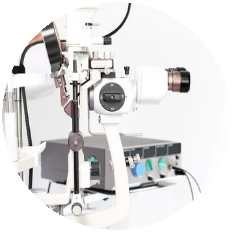Blepharitis & Meibomian Gland Dysfunction (MGD)
Causes, Symptoms and Treatment
Understanding Blepharitis and MGD
The term blepharitis refers to inflammation of the eyelid. The lids become red and irritated with dandruff- like scales forming on the eyelashes.
Some people may experience a single episode of blepharitis, which is easily treated. Other people, however, can suffer from chronic blepharitis. Blepharitis treatment will depend on the underlying cause.
Blepharitis is divided into two categories, based on where on the lid the inflammation occurs.
• Front or anterior part of the lid
• Back or posterior part of the lid
Front or Anterior Part of the Lid
Blepharitis in this location is often caused by infection of the lid margin and leads to deposits on the eyelashes and a swollen eyelid. Bacteria secrete irritating substances which get into the eye, resulting in discomfort. There is also a skin condition called seborrheic blepharitis, which is a form of eczema.
Back or Posterior Part of the Lid
This form of blepharitis is caused by a condition called meibomian gland dysfunction (MGD). MGD is by far the main cause of blepharitis and causes dry eye symptoms. Sometimes it occurs secondary to rosacea, but it can also happen with no apparent underlying causes. In older people, blepharitis is mostly caused by demodex mite infestation.
Meibomian Gland Dysfunction (MGD)
The meibomian glands are tiny glands in our eyelids, producing oils that form the top layer of the tear film. These oils prevent the water in your tears from drying out, making them essential for eye comfort as well as for visual acuity.
When the meibomian glands become blocked by hardened oil secretions, or there is narrowing/blockage of the ducts, they can no longer express oil. Eyelids become inflamed as a result of the blockage, and the lack of oil leaves the eyes dry.
A chalazion (meibomian cyst) may develop on the eyelid. This red bump may be painful initially but the pain will go away within a short time. Chalazions will usually go away by themselves once the blocked gland is treated.


MGD Treatments
MGD is a chronic condition and is not readily cured. However, with treatment, the symptoms can be relieved somewhat and progression slowed. Without treatment, blocked meibomian glands will eventually atrophy and drop out. As this is often non-reversible, early treatment for MGD is vital to prevent lasting damage to the meibomian glands.
There are multiple treatment options available, some of which are cannot be accessed on the NHS but are offered by the Dry Eyes Clinic. When you visit, our consultant will undertake cutting-edge diagnostic testing, take a full medical history and guide you to the most appropriate and effective treatment for your case.








